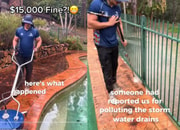
As the temperature rises and daylight lingers, many Australians over 60 are noticing that they are not alone in seeking refuge indoors.
Uninvited guests—cockroaches, mice and other pests—are staging their annual invasions.
Some of the patterns this year are more alarming than usual.
Sydney named Australia’s pest capital
New research from Airtasker has crowned Sydney as Australia’s pest capital, with eight of the nation’s ten most pest-affected areas located within Greater Sydney.
For older residents, the news carries concerns far beyond spotting a scuttling cockroach.
Sydney’s City and Inner South topped the national list with a pest score of 61.04 out of 100, followed by the Eastern Suburbs on 56.16 and the Inner West on 51.21.
These areas recorded more than 7,300 pest-related Google searches per 100,000 people, suggesting residents are actively seeking solutions.
If you see one cockroach, there are probably dozens more nearby.
Licensed pest technician Ibby El-Jamal describes the conditions as ‘a paradise for cockroaches and rodents’ once warm weather sets in.
Brisbane’s Inner City ranked fourth nationally with 48.33, largely due to humidity and high pet ownership contributing to flea infestations.
Melbourne’s inner suburbs came sixth with 44.18 but recorded the highest rate of rodent infestations, as rats and mice sought warmth in dense housing during cooler months.
Health risks from pests
Older Australians are particularly vulnerable to health risks from pests, with weaker immune systems making them more susceptible to illnesses.
Termites, mosquitoes, rodents, flies, fleas, rats and mice, cockroaches, bed bugs and ants can all carry harmful pathogens.
Common health risks for seniors from household pests
Cockroaches and rodents can trigger asthma and allergies
Bed bugs can cause skin irritation and sleep disruption
Rodent droppings carry diseases like Salmonella
Fleas can cause significant discomfort, especially for those with pets
Wasps pose serious sting risks for those with compromised immune systems
Pests can irritate wounds, contaminate food and trigger allergies, while also causing anxiety and distress for older residents who feel unable to manage infestations independently.
The cost of pest control varies nationwide, ranging from $147 to $467, but complex infestations involving termites or bed bugs can exceed $4,000—a significant burden for retirees on fixed incomes.
Urban pest costs and seasonal surges
Sydney households face the highest costs, paying up to 80 per cent more than regional areas due to high demand and limited pest control availability.
This can make the difference between addressing a problem early or letting it worsen.
Airtasker data shows pest-related tasks have risen 24.1 per cent since 2020, with requests peaking in December and January—122 per cent higher than average.
Many seniors face this seasonal surge while hosting family over the holidays.
Even after professional fumigation, toxic chemicals can linger for weeks and pose serious risks to the elderly.
Using eco-friendly and non-toxic products is critical, and treatments should be APVMA-approved to ensure safety.
Questions to ask pest control providers
- Do you use APVMA-approved products?
- Can you provide eco-friendly, non-toxic options?
- How long before the home is safe to occupy after treatment?
- Do you have experience working with elderly clients?
- Can you provide written safety instructions?
Prevention strategies
Prevention remains the most effective strategy and can often be done safely without harsh chemicals or climbing ladders.
Seal entry points at ground level by checking door seals, window screens and gaps around pipes.
Use weather stripping or caulk to close small gaps.
Maintain dry conditions by fixing leaky taps promptly and ensuring good ventilation in kitchens and bathrooms.
Transfer pantry items to sealed containers to prevent infestations and spot problems early.
Wipe down surfaces after meals and avoid leaving dishes overnight—consistent small efforts outperform occasional deep cleans.
While DIY products exist, many are unsafe for seniors.
Professional services can assess specific situations, recommend the safest options and provide follow-up support, with some offering senior discounts.
Non-toxic DIY methods include essential oil deterrents, sticky traps placed safely away from walkways, and natural repellents such as coffee grounds for ants.
Timing and rural considerations
With summer approaching, preparation is key, particularly before December and January when pest activity peaks.
Scheduling a professional inspection in November can improve availability and potentially reduce costs.
Rural Australians face lower pest risks, with Western Australia’s South Outback recording the lowest activity at 12.32, followed by the Wheat Belt at 15.43 and North Outback at 16.10.
Urban living offers convenience but comes with higher pest risks, yet proper preparation and safe strategies can prevent unwelcome visitors from spoiling summer.
What This Means For You
Inner-city areas tend to experience the highest levels of pest activity, meaning homes in these locations are more likely to face infestations that can disrupt daily life.
For older adults, this risk is particularly concerning, as weaker immune systems make it harder to combat illnesses carried by rodents, cockroaches, and other common pests.
On top of the health concerns, the cost of pest control can be significant, with urban residents often paying more due to higher demand and limited service availability.
For seniors living in city environments, taking preventive measures, seeking professional advice, and using non-toxic treatments are essential strategies to manage infestations safely, protect their health, and maintain a comfortable home environment.
If you’re looking for practical ways to keep pests out of your home, there’s a clever approach that has helped many households stay bug-free.
This method focuses on non-toxic, easy-to-use remedies that target spiders, fruit flies, and other common invaders before they become a real problem.
It’s a great follow-up to what we’ve discussed about preventing infestations and maintaining a comfortable, healthy home.
Australia's most pest-infested cities and suburbs revealed: is yours on the list? — Reveals that eight of the nation's ten most pest-affected areas are within Greater Sydney, highlighting urban pest hotspots.
https://7news.com.au/lifestyle/real-estate/australias-most-pest-infested-cities-and-suburbs-revealed-is-yours-on-the-list-c-20363947
Is pest control safe for babies, children & the elderly in Australia? — Discusses that homes can retain toxic chemicals for weeks after fumigation, posing risks to vulnerable groups.
https://expertpestcontrol.com.au/blog/article/is-pest-control-safe-for-babies-children-and-the-elderly-in-australia/
Aged Care Pest Control — Highlights that elderly individuals are more susceptible to diseases carried by pests due to weaker immune systems.
https://safespraypestcontrol.com.au/industry-sectors/aged-care
Aged Care and Retirement Homes Pest Control Management Services Sydney — Notes that elderly individuals’ weaker immune systems increase vulnerability to illnesses transmitted by pests such as termites and mosquitoes.
https://generapestmanagement.com/aged-care-pest-control-sydney/
Pest Control Aged Care Facilities—Federal Pest Control — Emphasises that seniors with compromised immune systems are particularly at risk from pests like cockroaches and rodents.
https://commercial.fedpest.com.au/aged-care/
Keeping Senior Living Facilities Pest-Free: A Guide from Consolidated Pest Control — Explains that pests in senior living facilities can cause anxiety, discomfort, and distress among residents.
https://consolidatedpestcontrol.com/keeping-senior-living-facilities-pest-free-a-guide-from-consolidated-pest-control/
Aged Care and Retirement Homes Pest Control Management Services Sydney — Advises that pest control treatments in aged care facilities must be safe, minimally disruptive, and eco-friendly due to residents’ vulnerability.
https://generapestmanagement.com/aged-care-pest-control-sydney/
Have you noticed increased pest activity in your area this year, and what strategies have worked best to keep your home safe?







